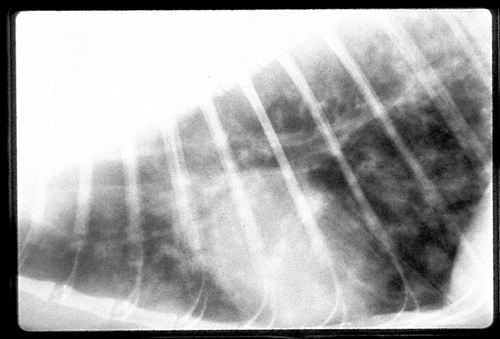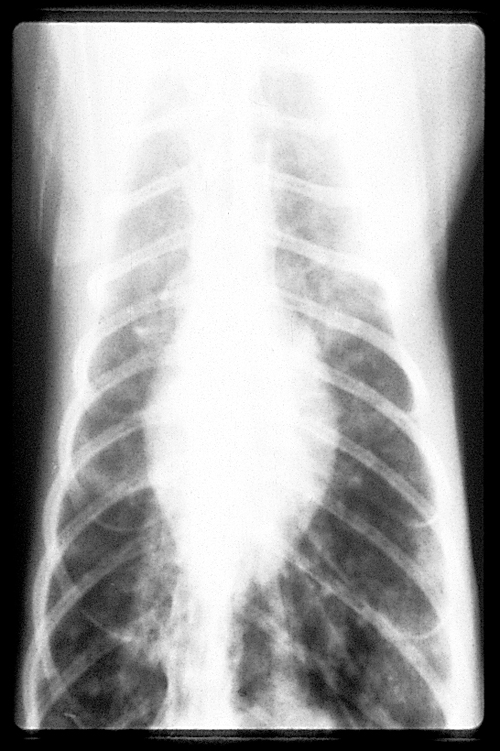Difference between revisions of "Small Animal Emergency and Critical Care Medicine Q&A 06"
Ggaitskell (talk | contribs) |
|||
| (One intermediate revision by one other user not shown) | |||
| Line 1: | Line 1: | ||
| + | {{Template:Manson | ||
| + | |book = Small Animal Emergency and Critical Care Medicine Q&A}} | ||
| + | |||
| + | |||
[[Image:ECC 06a.jpg|centre|500px]]<br> | [[Image:ECC 06a.jpg|centre|500px]]<br> | ||
[[Image:ECC 06b.jpg|centre|500px]] | [[Image:ECC 06b.jpg|centre|500px]] | ||
| Line 12: | Line 16: | ||
|a1= | |a1= | ||
Feline asthma. | Feline asthma. | ||
| − | |l1= | + | |l1=Feline Asthma Syndrome |
|q2=Describe your initial therapeutic plan and options should the cat worsen. | |q2=Describe your initial therapeutic plan and options should the cat worsen. | ||
|a2= | |a2= | ||
| Line 18: | Line 22: | ||
Should the cat worsen, epinephrine (1:10,000) (0.25–0.75 ml i/m) can be used, or an albuterol asthma inhaler discharged during an open mouthed inspiration. | Should the cat worsen, epinephrine (1:10,000) (0.25–0.75 ml i/m) can be used, or an albuterol asthma inhaler discharged during an open mouthed inspiration. | ||
| − | |l2= | + | |l2=Feline Asthma Syndrome#Treatment |
|q3=What radiographic changes do you expect to see? | |q3=What radiographic changes do you expect to see? | ||
|a3= | |a3= | ||
Hyperinflation of the lungs; flattening of the diaphragm; bronchiolar markings. | Hyperinflation of the lungs; flattening of the diaphragm; bronchiolar markings. | ||
| − | |l3= | + | |l3=Feline Asthma Syndrome#Diagnosis |
|q4=What are concerns for long-term control? | |q4=What are concerns for long-term control? | ||
|a4= | |a4= | ||
| Line 30: | Line 34: | ||
Should the cat have severe attacks, the owner can keep an albuterol inhaler. | Should the cat have severe attacks, the owner can keep an albuterol inhaler. | ||
| − | |l4= | + | |l4=Feline Asthma Syndrome#Treatment |
</FlashCard> | </FlashCard> | ||
Latest revision as of 17:38, 30 September 2011
| This question was provided by Manson Publishing as part of the OVAL Project. See more Small Animal Emergency and Critical Care Medicine Q&A. |
A six-year-old, female, spayed domestic shorthair cat was presented with a history of occasional coughing. In the last 12 hours the cat has coughed with increased frequency and is now in significant respiratory distress. Physical examination finds the cat open mouth breathing, ‘air hungry’ and aggressive. The cat has a prolonged expiratory phase of breathing. Auscultation finds high pitched wheezes and normal HR, rhythm and sounds. The pulses are strong. This is all you can examine.
| Question | Answer | Article | |
| What is your tentative diagnosis from the breathing pattern, auscultation and history? | Feline asthma. |
Link to Article | |
| Describe your initial therapeutic plan and options should the cat worsen. | Oxygen by flow-by or small cage; i/v catheter if possible; sedation – butorphanol may be sufficient; fast-acting glucocorticoids; nebulized bronchodilators such as terbutaline (cats will actually seek out this ‘mist’ and sit with their noses against the outflow spout!). Should the cat worsen, epinephrine (1:10,000) (0.25–0.75 ml i/m) can be used, or an albuterol asthma inhaler discharged during an open mouthed inspiration. |
Link to Article | |
| What radiographic changes do you expect to see? | Hyperinflation of the lungs; flattening of the diaphragm; bronchiolar markings. |
Link to Article | |
| What are concerns for long-term control? | Examination of the environment for inhaled allergens – cigarette smoke is a common initiator. Cats can often be weaned off glucocorticoids and it is then given only as needed by the owner. Should the cat have severe attacks, the owner can keep an albuterol inhaler. |
Link to Article | |

